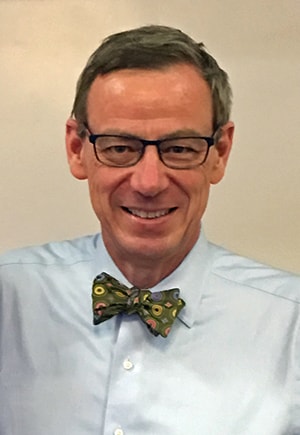Curtis A. Meyer
Otto Stern Professor of Physics
Professor by Courtesy, Pittsburgh Supercomputing Center
Nuclear & Particle Physics
Quark Interaction Experiment
Wean Hall 8410

Research Interests
Most of the visible mass of the universe is composed of protons and neutrons—particles which build up the cores of atoms. However, the protons and neutrons (nucleons) are themselves composed of more fundamental particles known as quarks and gluons and interestingly, these small constituents appear to be forever trapped inside their respective parent. An article in an August 2000 issue of the New York Times listed understanding confinement of quarks inside of protons and neutrons as one of the ten fundamental questions in physics to ponder for the 'next millennium or two'. While we believe that the theory of Quantum Chromodynamics, (QCD), can explain this confinement, an exact understanding of how QCD works has been extremely elusive.
We know that QCD works under the extreme conditions found in high energy particle collisions, but our knowledge of what it is doing under normal conditions found in the every day world is quite limited. Using advances in high speed computing and experimental facilities that could soon be available at laboratories in the United States, scientists hope to go a long way in answering this question within the next decade. In addition to the question of confinement, there has been a long-standing question on how the nominal three quarks inside of a nucleon behave. Are they free to bounce around like marbles in a fishbowl or are they somehow constrained to move together—what are the degrees of freedom inside the nucleon? This latter question can be answered by looking at what happens when the quarks inside a nucleon are excited, and thereby creating new particles. The spectrum of these particles is connected to the degrees of freedom.
Advances in a technique called lattice gauge QCD and significant improvements in computation power have combined to make the solution to QCD within reach. Lattice QCD solves QCD exactly in a discretized space-time world, but to do so, it requires massive computational power. Multi-teraflop computers are needed to allow theorists to do these calculations and to make detailed predictions for the spectrum of exotic hybrid mesons. Extensive results from Lattice QCD over the last few years predict the entire spectrum of quark-antiquark particles, and are able to identify many that are associated with the excitation of the gluonic filed holding the quarks together. As expected from earlier work, many of these exhibit an unambiguous experimental signature that can be searched for. The final arbiter in determining what is correct is experiment. So in parallel, we have been building a new experimenter at Jefferson Lab that will be able to study experimentally what is suggested by theory. The GlueX experiment will carry out studies to map out the spectrum of this new type of matter with a focus on those with a signature distinctly different from normal mesons.
The GlueX experiment, of which I am Spokesperson, took its first commissioning data in fall 2014 and had a major Engineering Run in the spring of 2016. First physics running started early in 2017 and will continue into the foreseeable future. The full experimental program aimed at addressing these issues in QCD will continue for many years into the future. New collaborators now will be joining in during the most exciting phase of any experimental program: the first data.
GlueX Info:
Education & Professional Experience
Ph.D.: UC Berkeley (1987)
M.A.: UC Berkeley (1984)
Professional Societies:
Fellow, American Physical Society
Professor of Physics, Carnegie Mellon University, 2002–
Chief Information Officer, DigitalMC, 2000–03
Indefinite Tenure, Carnegie Mellon University, 1999
Associate Professor, Carnegie Mellon University, 1997–2002
Assistant Professor, Carnegie Mellon University, 1993–97
Post-doctoral Research: University of Zürich (Switzerland), 1987–93
Recent Publications
J.T. Goetz et al. [CLAS Collaboration], Study of Ξ∗ Photoproduction from Threshold to W = 3.3 GeV, Phys. Rev. C 98, 062201(R) (2018)
N. Hirlinger Saylor et al. [CLAS Collaboration], Measurement of Unpolarized and Polarized Cross Sections for Deeply Virtual Compton Scattering on the Proton at Jefferson Laboratory with CLAS, Phys. Rev. C 98, 045203, (2018)
S. Lombardo et al. [CLAS Collaboration], Photoproduction of K+K- meson pairs on the proton, Phys. Rev. D 98, 052009, (2018)
E. Golovatch et al. [CLAS Collaboration], First results on nucleon resonance photocouplings from the γp → π+π−p reaction, Phys. Lett. B 788, 371-379, (2018)
D.H. Ho et al. [CLAS Collaboration], Beam-Target Helicity Asymmetry E in K0Λ and K0Σ0 Photoproduction on the Neutron, Phys. Rev. C 98, 045205, (2018)
E.O. Cohen et al. [CLAS Collaboration], Center of Mass Motion of Short-Range Correlated Nucleon Pairs studied via the A(e,e′pp) Reaction, Phys. Rev. Lett. 121, 092501 (2018)
T.D. Beattie et al., Construction and Performance of the Barrel Electromagnetic Calorimeter for the GlueX Experiment, Nucl. Instrum. Meth. A 896, 24 (2018)
S. Chandavar et al. [CLAS Collaboration], Double K0S Photoproduction off the Proton at CLAS, Phys. Rev. C 97, 025203 (2018)
P. Roy et al. [CLAS Collaboration], Measurement of the beam asymmetry Σ and the target asymmetry T in the photoproduction of ω mesons off the proton using CLAS at Jefferson Laboratory, Phys. Rev. C 97, 055202 (2018)
K.P. Adhikari et al. [CLAS Collaboration], Measurement of the Q2-dependence of the deuteron spin structure function g1 and its moments at low Q2 with CLAS, Phys. Rev. Lett. 120, 062501 (2018)
S. Jawalkar et al. [CLAS Collaboration], Semi-inclusive π0 target and beam-target asymmetries from 6 GeV electron scattering with CLAS, Phys. Lett. B 782, 662 (2018)
More Publications:
ORCID Researcher ID Google Scholar Scopus